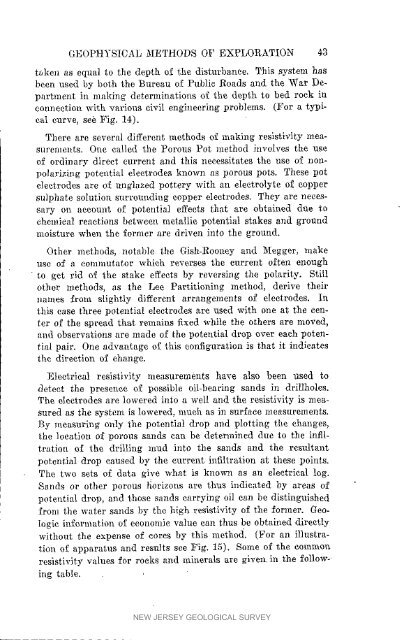Bulletin 54. Geophysical Methods of Exploration and their ...
Bulletin 54. Geophysical Methods of Exploration and their ...
Bulletin 54. Geophysical Methods of Exploration and their ...
Create successful ePaper yourself
Turn your PDF publications into a flip-book with our unique Google optimized e-Paper software.
GEOPHYSICAL METHODS OF EXPLORATION 43<br />
token as equal to the depth <strong>of</strong> the disturbance. This system has<br />
been used by both the Bureau <strong>of</strong> Public Roads <strong>and</strong> the War Department<br />
in making determinations <strong>of</strong> the depth to bed rock in<br />
connection witk various civil engineering problems. (For a typical<br />
curve, see Fig. 14).<br />
There are several different methods <strong>of</strong> making resistivity measurements.<br />
One called the Porous Pot method involves the use<br />
<strong>of</strong> ordinary direct current <strong>and</strong> this necessitates the use <strong>of</strong> nonpolarizing<br />
potential electrodes known as porous pots. These pot<br />
electrodes are o2 unglazed pottery with an electrolyte <strong>of</strong> copper<br />
sulphate solutiou surrounding copper electrodes. They are necessary<br />
on account <strong>of</strong> potential effects that are obtained due _o<br />
chemical reactions between metallic potential stakes <strong>and</strong> ground<br />
moisture when the former are driven into the ground.<br />
Other methods, notable the Gish-Rooaey aud Megger, n_ake<br />
use <strong>of</strong> a commutator which reverses the current <strong>of</strong>ten enough<br />
to get rid <strong>of</strong> the stake effects by reversing the polarity. Still<br />
other methods, as the Lee Partitioning method, derive <strong>their</strong><br />
names front slightly different arrangements <strong>of</strong> electrodes. In<br />
this case three potential electrodes arc used with one at the center<br />
<strong>of</strong> the spread that remains fixed while the others are moved,<br />
<strong>and</strong> observations are made <strong>of</strong> the potential drop over each potential<br />
pair. One advantage <strong>of</strong> this configuration is that it indicates<br />
the direction <strong>of</strong> change.<br />
Electrical resistivity measurements have also been used to<br />
detect the presence <strong>of</strong> possible oil-bearing s<strong>and</strong>s in drillholes.<br />
The electrodes are lowered into a well <strong>and</strong> the resistivity is measured<br />
as the systent is lowered, much as in surface measurements.<br />
By measuring only the potential drop <strong>and</strong> plotting the changes,<br />
the location <strong>of</strong> porous s<strong>and</strong>s can be determined due to the infiltration<br />
<strong>of</strong> the drilling _nud into the s<strong>and</strong>s <strong>and</strong> the resultant<br />
potential drop caused by the current infiltration at these points.<br />
The two sets <strong>of</strong> data give what ]s known as an electrical log.<br />
S<strong>and</strong>s or other porous t{orizons are thus indicated by areas <strong>of</strong><br />
potential drop, <strong>and</strong> these s<strong>and</strong>s carrying oil can be distinguished<br />
front the water s<strong>and</strong>s by the high resistivity <strong>of</strong> the former. Geologic<br />
information <strong>of</strong> economic value can thus be obtained directly<br />
without the expense <strong>of</strong> cores by this method. (For an illustration<br />
<strong>of</strong> apparatus <strong>and</strong> results see Fig. 15). Some <strong>of</strong> the common<br />
resistivity values for rocks <strong>and</strong> minerals are given, in the following<br />
table.<br />
NEW JERSEY GEOLOGICAL SURVEY

















